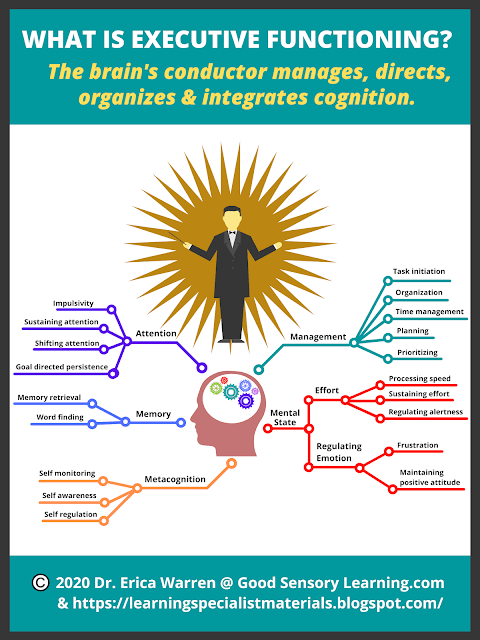This week I wanted to tell you about my online store, Good Sensory Learning. I’m Dr. Erica Warren, and I established this site so I could share all the materials that I have created over the last 20+ years as a learning specialist and educational therapist. When I first began my private practice, Learning to Learn, I had great difficulty finding fun and multisensory materials for my students that were effective and engaging. So back in 2005, I made it my mission to design and distribute high-end, remedial products as well as memorable, motivating lessons that bring delight to learning. If you would like to try a free sampling of my activities , CLICK HERE . How Are the Products Organized at Good Sensory Learning? You can download my Free Printable Catalog or you can browse the site using the grey “search all products” bar in the top right of any page with keywords such as dyslexia, working memory, and executive functioning. What’s more, drop down menus in the red banner allow you t...
Although there is no specific diagnosis for executive function disorder, the term is often used to describe the impairment in one's ability to manage their own cognition or executive functions.
 The Executive Functioning Cognitive Remedial Bundle presents a comprehensive approach to exercising and improving executive functioning capabilities. This discounted suite presents downloadable activities, handouts, and games designed for learning specialists, educational therapists, and even parents to assist learners in strengthening executive functioning skills. CLICK HERE to learn more.
The Executive Functioning Cognitive Remedial Bundle presents a comprehensive approach to exercising and improving executive functioning capabilities. This discounted suite presents downloadable activities, handouts, and games designed for learning specialists, educational therapists, and even parents to assist learners in strengthening executive functioning skills. CLICK HERE to learn more.
Dr. Erica Warren is the author, illustrator, and publisher of multisensory educational materials at Good Sensory Learning and Dyslexia Materials. She is also the director of Learning to Learn and Learning Specialist Courses.
· Blog: https://learningspecialistmaterials.blogspot.com/
· YouTube Channel: https://www.youtube.com/user/warrenerica1
· Podcast: https://godyslexia.com/
· Store: http://www.Goodsensorylearning.com/ & www.dyslexiamaterials.com
· Courses: http://www.learningspecialistcourses.com/
· Newsletter Sign-up: https://app.convertkit.com/landing_pages/69400
What are Executive Functions?
Executive function is a term that has become more and more popular in the educational realm as it can have a profound impact on learning. Executive functions (EFs) collect sensory inputs as well as memories and processes from different parts of the brain. It also has its own virtual whiteboard where one can utilize the inner voice and visualizations to hold and arrange simple cognitive manipulations and tasks.What are the 5 Main Roles of Executive Functioning?
- Management involves task initiation, organization of information, time management, planning, and prioritization.
- Mental State includes both effort (speed and alertness) as well as emotional regulation or the management of moods and feelings.
- Metacognition or the awareness of one's thoughts entails monitoring awareness and regulation of those thoughts.
- Memory grants access to present and prior knowledge.
- Attention concerns the shifting, sustaining and managing of one's focus.
Where is Executive Functioning Located in the Brain?
EFs are situated mainly in the prefrontal locations of the frontal lobe. Like a conductor, EFs receive incoming sensory input as well as information from other parts or instruments of the brain. Like an orchestra, the brain combines this information into a united symphony of consciousness.
This YouTube video offers more information about the prefrontal cortex:
How Can We Help Students With Executive Functioning Disorder?
 The Executive Functioning Cognitive Remedial Bundle presents a comprehensive approach to exercising and improving executive functioning capabilities. This discounted suite presents downloadable activities, handouts, and games designed for learning specialists, educational therapists, and even parents to assist learners in strengthening executive functioning skills. CLICK HERE to learn more.
The Executive Functioning Cognitive Remedial Bundle presents a comprehensive approach to exercising and improving executive functioning capabilities. This discounted suite presents downloadable activities, handouts, and games designed for learning specialists, educational therapists, and even parents to assist learners in strengthening executive functioning skills. CLICK HERE to learn more.Cheers, Dr. Erica Warren
· Blog: https://learningspecialistmaterials.blogspot.com/
· YouTube Channel: https://www.youtube.com/user/warrenerica1
· Podcast: https://godyslexia.com/
· Store: http://www.Goodsensorylearning.com/ & www.dyslexiamaterials.com
· Courses: http://www.learningspecialistcourses.com/
· Newsletter Sign-up: https://app.convertkit.com/landing_pages/69400


Comments
Post a Comment